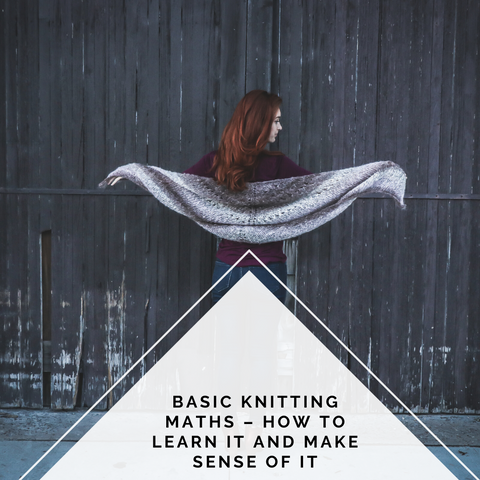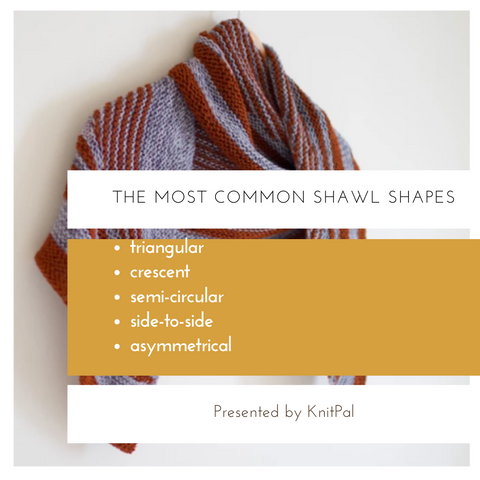
Basic knitting maths – How to Learn It and Make Sense of It
Maths. Not usually associated with knitting, it often attracts groans from hobbyists who simply want to knit and not be bothered by the ins and outs of maths. However, all knitters do maths practically the whole time they are knitting without really realising it and, with a few tricks up your sleeve, you’ll soon start to understand how knitting patterns work.

Understanding the patterns not only means that you can more easily find and fix mistakes, but also that you can start designing your own knitting patterns!
In this article, we’ll look at the basics of knitting maths and some of the basic formulas that will help you to design your own shawl.
The basics of knitting maths
Knitting maths deals in increases and decreases – adding and subtracting. While this sounds easy enough, some patterns can have very advanced lace patterns, for example, that need to increase and decrease in a very specific way so you end up with a shawl and not a pile of knotted yarn.
For example, if you’re knitting a rectangle (like a scarf) or a square, you will need to make sure that you always have the same amount of stitches on the needles in order to keep the shape of the piece. In other words, for every decreased stitch, there has to also be an increased stitch in the same row.
Rather than lace knitting being a magical way in which patterns are created, it’s a very involved mathematical formula (which, let’s be honest, sometimes looks a bit like a magic formula).
Now that you know that the knitting patterns are all just a matter of increases and decreases, you will be able to correct mistakes more easily – for example, if you see that there is suddenly a stitch “missing”, you’ll know that in one of the rows you’ve just finished you dropped a stitch or decreased a stitch without increasing a stitch.
Should you have an extra stitch all of a sudden, you’ll know to look for the spot where you either did not decrease where you should have, or have picked up a stitch where you shouldn’t have.
Spotting and fixing does take some learning, but when you understand how the pattern works mathematically, you’ll see that you learn how to do it much faster and without guesswork.
Basic maths formulas for knitting basic shawls
Because the maths for knitting shawls can be elementary, we’re going to give some examples of the maths for shawls that will help you to further learn how knitting maths and knitting patterns work.
The most common shawl shapes, according to the Ponderosa Fibre Arts Guild, are:
- triangular
- crescent
- semi-circular
- side-to-side
- asymmetrical

The triangular, crescent, and semi-circular shawls are usually knit “top-down” – that is to say, they are started by casting on only a few stitches which are then incrementally increased to give the shawl the correct shape. Sometimes a pattern may require you to knit a shawl “bottom up”. In this case you start out by casting on a lot of stitches and decreasing them as you knit to get the correct shape.
The side-to-side and asymmetrical shawl, however, is knit from point-to-point width-wise to give the shawl the desired shape.
The triangular shawl patterns’ maths
Because the triangular shawl is such a favorite to knit, we’ll start with the pattern for knitting a basic triangular shawl.
In order for the triangle to be symmetrical, you need to increase the same amount of stitches on each side of the “spine” (middle stitch/stiches) of the shawl. Because of all of these increases, it’s a good idea to mark the centre stitch or stitches of the shawl.
For a deep triangular shawl, you will need to increase two stitches on the outside of the shawl every first row, and four stitches – two on the outside and two in the centre, one on either side of the spine – every second row. Repeat the increases of these two rows until the desired size is reached.
For a triangle that is not as deep, you need only increase four stitches – two on the outside and one on either side of the spine – every right side row. No increases are made on the second (or wrong side) rows.
For a very shallow triangle, you need only increase stitches on the outside of the shawl every row.
The crescent shawl patterns’ maths
Crescent shawls are worked in a similar way to the triangular shawls with the main difference being that the increases are only on the outside of the rows and not on the outside and along the spine.
The basic crescent shape is knit by making two increases on either end of the row on the right side, with one increase on either end on the wrong side. Because you increase by six stitches at the ends for every two rows, the shawl grows more in length than in depth and gets its familiar crescent shape.
Asymmetrical and side-to-side shawl patterns
The maths for asymmetrical and side-to-side shawls are not as straight forward as the shawls mentioned above. However, for both of these shawls, you start knitting at one point of the shawl (with only a few stitches) and work increases until your shawl has reached the required width. Then decreases are worked until the other point of the shawl is reached. The Ponderosa Fibre Arts Guild gives a good overview with photos of the different ways in which these asymmetrical and side-to-side shawls can be constructed.
The best way to learn how these increases and decreases influence a shawl’s shape, is to knit them yourself, however. By knitting swatches of shawls (or full-sized ones if you want) you will soon get the hang of the maths that goes into knitting a specific shape!
Ready to knit a shawl? Be sure to check out the KnitPal End-Run Shawl Kit!
Tip! When you buy KnitPal knitting kits, you can rest assured that you will have enough yarn to finish your project without having yarn left over that is too short to make anything with, and too long to just throw away.
Additional resources:
Ponderosa Fibre Arts Guild, “Shawl Shapes – An Overview of the Construction Elements of Five Different Shawls”, October 2018.
Rosee Woodland, “Shawl Design for Beginners”, August 2019.
Sister Mountain, “Do you need to be good at maths to be a knitting pattern designer?”, March 2020.

